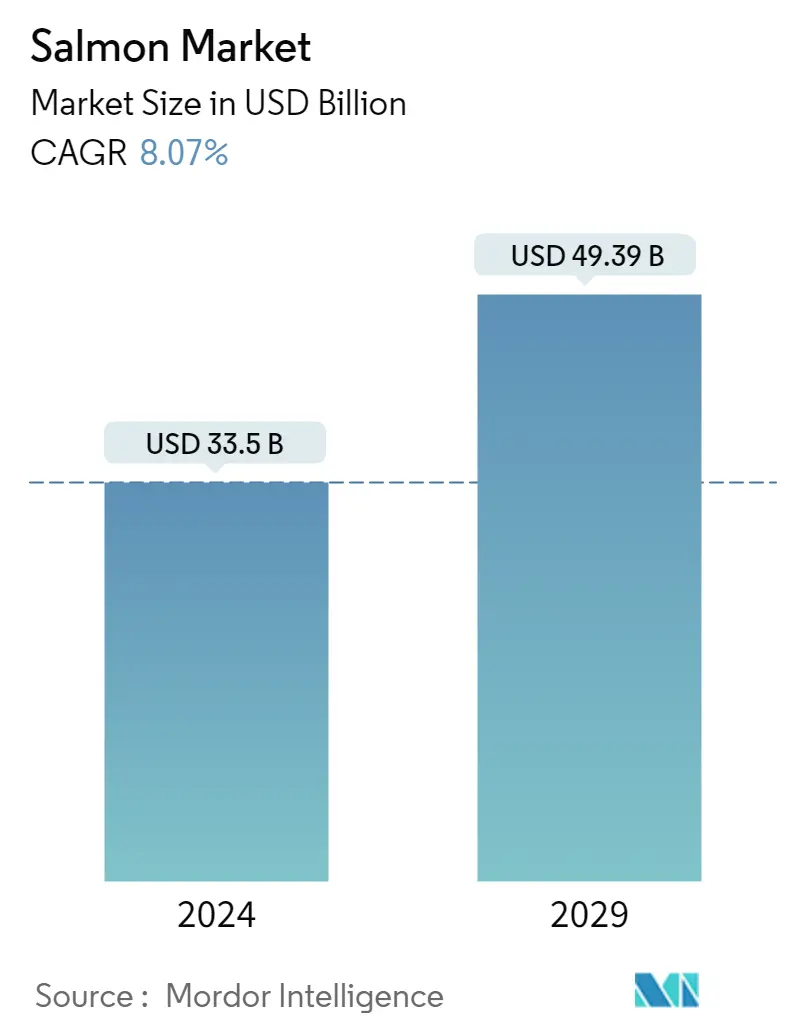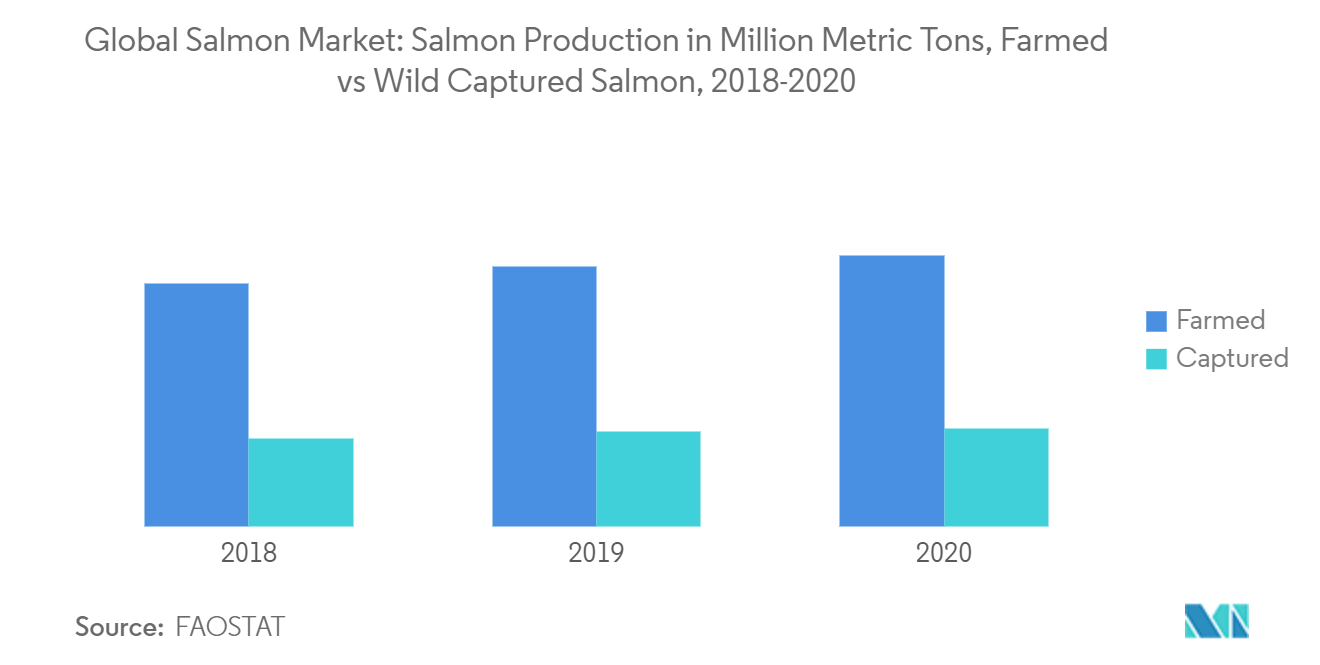Salmon Market Size

| Study Period | 2019 - 2029 |
| Market Size (2024) | USD 33.50 Billion |
| Market Size (2029) | USD 49.39 Billion |
| CAGR (2024 - 2029) | 8.07 % |
| Fastest Growing Market | South America |
| Largest Market | Europe |
Major Players*Disclaimer: Major Players sorted in no particular order |
Salmon Market Analysis
The Salmon Market size is estimated at USD 33.5 billion in 2024, and is expected to reach USD 49.39 billion by 2029, growing at a CAGR of 8.07% during the forecast period (2024-2029).
The global salmon sector has felt the impact of COVID-19 all along the supply chain, with production, processing, and logistics. In Norway, prices were very high in Q1, at over NOK 70 per kilo, and producers have benefitted from several strong years of prices, making the sector fairly resilient. In Chile, quarantines, curfews, and other COVID-19 restrictions have led to lower volumes of salmonids reaching processing plants.
Due to biological constraints, seawater temperature requirements, and other natural constraints, farmed salmon is mainly produced in the sea in Norway, Chile, the United Kingdom, North America, the Faroe Islands, Iceland, Ireland, New Zealand, and Tasmania. In 2020, more than 2.6 million tons of farmed salmonoids were produced. In comparison, only around 550,000 tons of wild salmonids were caught, with farmed salmon capturing nearly 74% of the overall salmon production in the world. Atlantic salmon is one of the most commonly cultured species of salmon across the world. The overall production of farmed Atlantic salmon was marked at 2.4 million metric ton in 2018, which increased to 2.74 million metric ton by 2020.
Good production of farmed Atlantic salmon had experienced a steep decline in the prices in both Norway and Chile in the first half of 2019. Subsequently, this declining price trend was sharply reversed, and prices soared to near-record heights, primarily attributed to the ever-strengthening demand in traditional and emerging markets such as China.
Salmon Market Trends
This section covers the major market trends shaping the Salmon Market according to our research experts:
Healthy Boost in the Salmon Production
The global production of farmed salmon peaked at 2.68 million metric tons in 2020, with Chile's aquaculture sector performance gradually improving over the past few years. This has resulted in increased salmon culture, especially Atlantic salmon culture, which is garnering nearly 74% of the salmon production in the world. The bulk of production increase is observed in Chile, at around 14% from 2018 to 2019, where a new regulatory regime is producing results. Similarly, in Norway, the world's largest producing country, a cold winter and fish health issues translated into a modest 5% increase in salmon harvests.
Moreover, the growth in supply is unable to satiate the salmon demand globally. As demand for salmon continues to strengthen globally, a combination of geographic and regulatory constraints on traditional open net-pen farming has limited the ability of producers to keep pace. However, increasing investments in the salmon production in the Chinese market, coupled with the technological approaches such as land and off-shore based culture and genetically engineered salmon, are some of the potential opportunities for pacing up the production further.

Chile leads the Salmon Market as Norway Grapple with Fish Health
The global supply growth of farmed salmon is led by Chile surpassing the constraints pertaining to the mass algal bloom mortalities, thereby maintaining its profitability. In 2020, more than one million metric ton of salmon were harvested in Chile, the country's highest value produced since 2007 as per Chilean trade body SalmonChile. Farmed salmon production uses 13 times less water, and its carbon footprint is ten times less than that of livestock.
The industry reached an agreement with Monetary Bay Aquarium in 2019 to reduce the use of antibiotics by 25% by 2050. In 2020, the industry lowered its antibiotic use rate to 298 grams-per-MT of biomass harvested, down from the 621 grams-per-metric ton it registered in 2016 and a 14.6% drop from the 349 grams-per-MT it used in 2019.
A relatively lower rate of production growth was observed in Europe, especially in Scotland, during the same period. For the past two years, Norwegian production has also been growing at a relatively slow rate due to regulatory constraints and sea lice difficulties. The total harvest quantity of salmonids in Norway in 2020 amounted to 1.46 million metric ton, representing an increase of 3.5% compared to 2019.
Norway's salmon industry had successfully pushed for bold changes in the supply chains for soya, an important vegetable component of salmon feed. All the Brazilian soy suppliers to the Norwegian salmon farming industry agreed to the implementation of a 100 % deforestation and conversion-free soybean value chain with 2020 as their cut-off date.
The Chilean salmon farming sector achieved very prospecting results. Production costs have fallen, and biological conditions at farms have reportedly improved, reflected in higher harvests that have even surpassed those of Norway. This is particularly driving the efforts to develop new approaches to farming, mainly focused on closed containment technologies, both on land and at sea. Also, new aquaculture operations are being set up in a variety of geographically dispersed countries, such as Iceland, the Russian Federation, and China, which is likely to spike up the salmon supply in the years to come.

Salmon Market Report - Table of Contents
1. INTRODUCTION
- 1.1 Study Deliverables
- 1.2 Study Assumptions and Scope of the Study
2. RESEARCH METHODOLOGY
3. EXECUTIVE SUMMARY
4. MARKET DYNAMICS
- 4.1 Market Overview
- 4.2 Market Drivers
- 4.3 Market Restraints
- 4.4 Supply Chain Analysis
5. MARKET SEGMENTATION
-
5.1 Species Type
- 5.1.1 Atlantic Salmon
- 5.1.2 Coho Salmon
- 5.1.3 Masu Salmon
- 5.1.4 Chinook Salmon
- 5.1.5 Other Species Types
-
5.2 Type
- 5.2.1 Farmed
- 5.2.2 Wild Captured
-
5.3 Geography
- 5.3.1 North America
- 5.3.1.1 United States
- 5.3.1.2 Canada
- 5.3.2 Europe
- 5.3.2.1 Norway
- 5.3.2.2 Spain
- 5.3.2.3 Netherlands
- 5.3.2.4 France
- 5.3.2.5 Italy
- 5.3.2.6 Greece
- 5.3.2.7 United Kingdom
- 5.3.2.8 Scotland
- 5.3.3 Asia-Pacific
- 5.3.3.1 China
- 5.3.3.2 Japan
- 5.3.3.3 Australia
- 5.3.4 South America
- 5.3.4.1 Chile
6. MARKET OPPORTUNITIES AND FUTURE TRENDS
7. AN ASSESSMENT OF THE IMPACT OF COVID-19
** Subject To AvailablitySalmon Industry Segmentation
Salmon is a fish species belonging to the family of salmonoids. For the purpose of the study, both the farmed and captured salmons have been considered for the market estimation. To avoid discrepancy and maintain accuracy, both fresh and processed salmon have been considered for capturing the market trends such as production, imports, exports, and consumption.
The salmon market is segmented by species type (Atlantic Salmon, Coho Salmon, Masu Salmon, Chinook Salmon, and other species types), type (farmed and wild captured), and geography (North America, Europe, Asia-Pacific, South America, and Africa). The report includes production (volume), consumption (volume and value), import (volume and value), export (volume and value), and price trend analysis. The report offers market size and forecasts in terms of value (USD million) and volume (metric ton) for all the above segments.
| Species Type | Atlantic Salmon | |
| Coho Salmon | ||
| Masu Salmon | ||
| Chinook Salmon | ||
| Other Species Types | ||
| Type | Farmed | |
| Wild Captured | ||
| Geography | North America | United States |
| Canada | ||
| Geography | Europe | Norway |
| Spain | ||
| Netherlands | ||
| France | ||
| Italy | ||
| Greece | ||
| United Kingdom | ||
| Scotland | ||
| Geography | Asia-Pacific | China |
| Japan | ||
| Australia | ||
| Geography | South America | Chile |
Salmon Market Research FAQs
How big is the Salmon Market?
The Salmon Market size is expected to reach USD 33.50 billion in 2024 and grow at a CAGR of 8.07% to reach USD 49.39 billion by 2029.
What is the current Salmon Market size?
In 2024, the Salmon Market size is expected to reach USD 33.50 billion.
Which is the fastest growing region in Salmon Market?
South America is estimated to grow at the highest CAGR over the forecast period (2024-2029).
Which region has the biggest share in Salmon Market?
In 2024, the Europe accounts for the largest market share in Salmon Market.
What years does this Salmon Market cover, and what was the market size in 2023?
In 2023, the Salmon Market size was estimated at USD 31 billion. The report covers the Salmon Market historical market size for years: 2019, 2020, 2021, 2022 and 2023. The report also forecasts the Salmon Market size for years: 2024, 2025, 2026, 2027, 2028 and 2029.
What are the biggest challenges for Salmon producers in emerging markets?
The biggest challenges for Salmon producers in emerging markets are a) Access to advanced technology b) Infrastructure limitations c) Competition from established players
Salmon Industry Report
The salmon industry is witnessing a significant upturn, fueled by an upsurge in health consciousness, innovative product offerings, and an escalating demand for protein-enriched foods. With a wide array of salmon forms available, including fresh, frozen, canned, and freeze-dried options, the market caters to an extensive variety of consumer preferences, emphasizing the nutritional benefits and convenience of salmon products like smoked salmon, salmon oil, and ready-to-eat seafood kits. The industry's growth is particularly notable in emerging markets across Asia and Latin America, alongside traditional markets in the U.S. and Europe. Atlantic salmon leads in market preference due to its availability and nutrient density, whereas Pacific salmon varieties are emerging favorites for their health benefits. The industry benefits from retail partnerships and online sales channels for wider market reach, segmented by species, form, and region to cater to diverse consumer needs, with a focus on sustainable practices and technological advancements to meet the rising global demand. Industry insights by Mordor Intelligence™ highlight the salmon market's projected growth and trends, available for deeper understanding through a complimentary free report PDF download.



